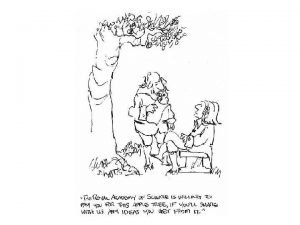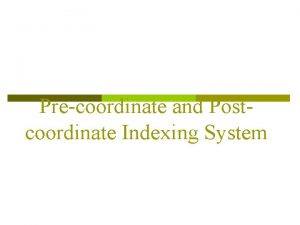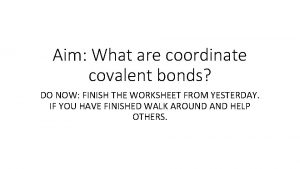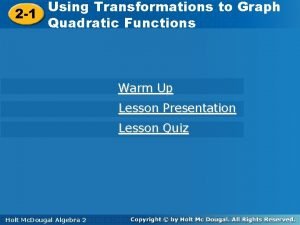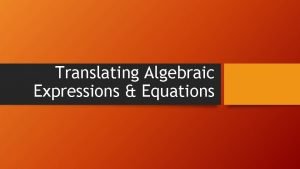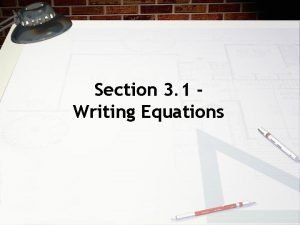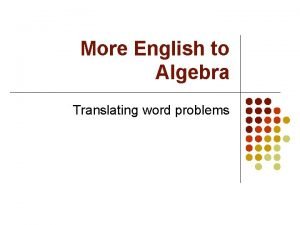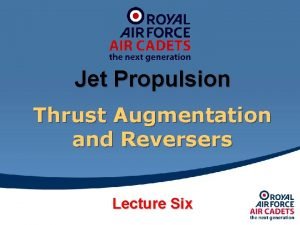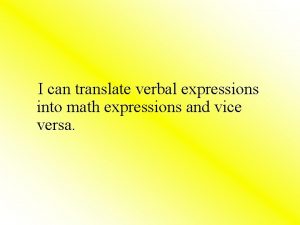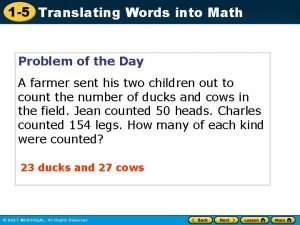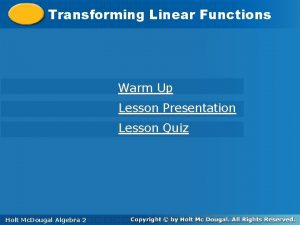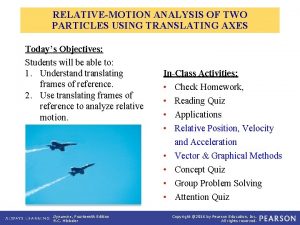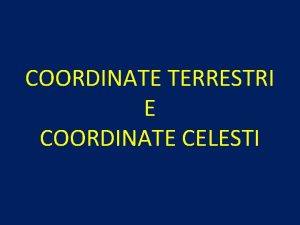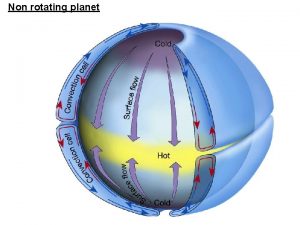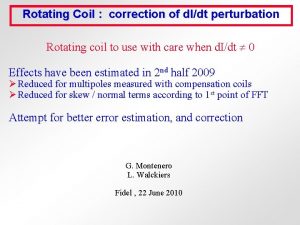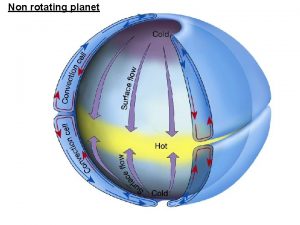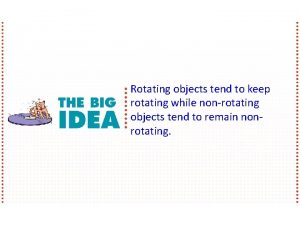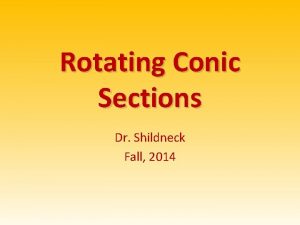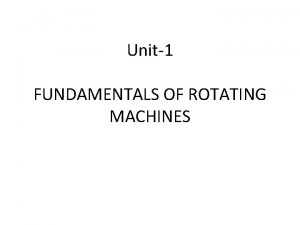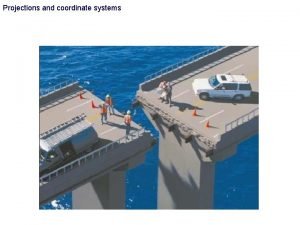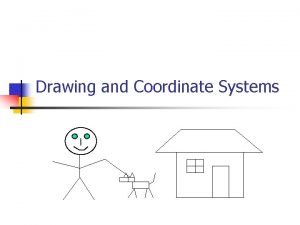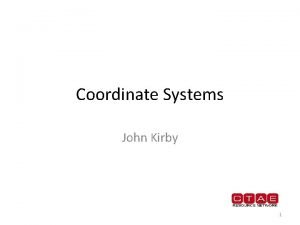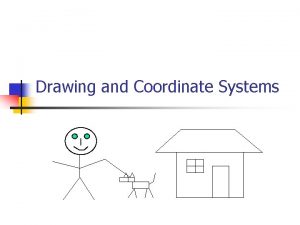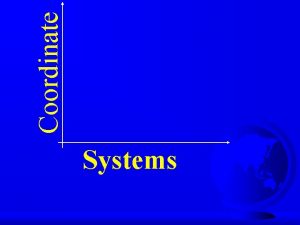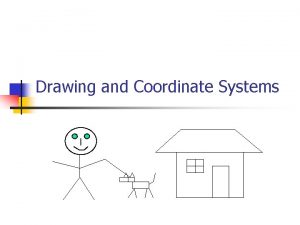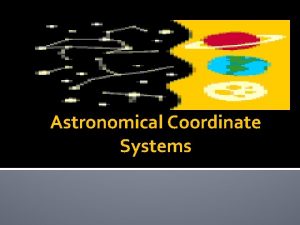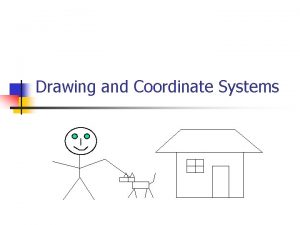Rotating Coordinate Systems For Translating Systems We just











![- m[ω (ω r)]: Centrifugal “Force” If ω r: This has magnitude mω2 r. - m[ω (ω r)]: Centrifugal “Force” If ω r: This has magnitude mω2 r.](https://slidetodoc.com/presentation_image_h/2be779b765d2ea7edcfcddb0349b8a44/image-12.jpg)




- Slides: 16


Rotating Coordinate Systems • For Translating Systems: We just got Newton’s 2 nd Law (in the accelerated frame): ma = F where F = F - ma 0 A non-inertial or fictitious force Solely from the COORDINATE TRANSFORMATION! Rotating systems are accelerating systems! • For Rotating Systems: Follow a similar procedure as for translating systems & similarly get: Newton’s 2 nd Law (in the accelerated frame): ma = F where F = F - mar A non-inertial or fictitious force: Solely from the COORDINATE TRANSFORMATION! For rotating systems: mar = much more complicated expressions than ma 0!

• As in our treatment of rigid bodies, consider again 2 sets of axes: – A “Fixed” or inertial set (space axes in Goldstein notation): (x 1, x 2, x 3) & A “Rotating” (body axes in Goldstein notation): (x 1, x 2, x 3). CAUTION! The treatment here & the associated figures are from Marion’s book. His unprimed coordinate system = the accelerating system & his primed system is fixed. The rotating system treatment in Goldstein uses the OPPOSITE notation: The primed system is accelerating (rotating) & the unprimed is fixed.

• 2 axis sets: “Fixed”: (x 1, x 2, x 3), “Rotating”: (x 1, x 2, x 3). • Consider point P in space. r in fixed system, r in rotating system. R = position of the origin of the rotating system with respect to the fixed axes: See fig: • Clearly: r = R + r

• To relate time derivatives in the fixed & rotating systems, use the results we had for rigid bodies (letting space = s fixed = f & r rotating ): (d/dt)fixed = (d/dt)rotating + ω or, for G = arbitrary vector, (d. G/dt)fixed = (d. G/dt)rotating + ω G (1) • First, special case: Let G = ω (angular velocity) Relation between time derivatives of ω (between angular accelerations) in fixed & rotating frames is: (dω/dt)fixed = (dω/dt)rotating + ω ω But ω ω = 0 (dω/dt)fixed = (dω/dt)rotating ω • Angular acceleration (sometimes called α ω) is the same in the fixed & rotating frames!

• Consider again point P: Position in fixed frame = r. Position in rotating frame = r. Position of origin of rotating frame in fixed frame = R. r = R + r (1) • Goal: Express velocity of point P in fixed system in terms of ω & velocity in rotating system: Moving frame is translating 1. Differentiate (1) in the fixed system: AND rotating! (dr /dt)fixed = (d. R/dt)fixed + (dr/dt)fixed 2. Use (dr/dt)fixed = (dr/dt)rotating + ω r (dr /dt)fixed = (d. R/dt)fixed + (dr/dt)rotating + ω r

(dr /dt)fixed = (d. R/dt)fixed + (dr/dt)rotating+ ω r (2) • Define: vf rf (dr /dt)fixed = Velocity relative to the fixed axes. V R (d. R/dt)fixed = Velocity (linear) of the moving origin (fixed frame). vr rr (dr/dt)rotating = Velocity (linear) relative to the rotating axes. ω Angular velocity ω r Velocity due to the rotation of the moving axes. (2) becomes: vf = V + vr + ω r

“Fictitious” Centrifugal & Coriolis Forces • Procedure (the same as for translational acceleration): Use Newton’s 2 nd Law & transform from the fixed axis system to rotating the axis system, using the operator: (d/dt)fixed = (d/dt)rotating + ω (1) on the velocity equation we just got! vf = V + vr + ω r (2) • A particle of mass m at point P under the influence of a net force F: Newton’s 2 nd Law is valid ONLY in the fixed, inertial frame (primed coordinates!): F = maf m(dvf/dt)fixed (3)

vf = V + vr + ω r • Differentiate (2) in fixed frame: (dvf/dt)fixed = [d(V + vr + ω r)/dt]fixed Or: (dvf/dt)fixed = (d. V/dt)fixed + (dvr/dt)fixed + [(dω/dt)fixed r] + ω (dr/dt)fixed (2) • Define: Af (d. V/dt)fixed (5) • Recall that (dω/dt)fixed ω (same in both frames). • By discussion we just had: (dvr/dt)fixed (dvr/dt)rotating + ω vr Or: (dvr/dt)fixed = ar + ω vr (4) (6) ar = Acceleration in rotating frame. • We know: (dr/dt)fixed (dr/dt)rotating + ω r Or: (dr/dt)fixed = vr + ω r vr = Velocity in rotating frame. (7)

• We had, F = maf m(dvf/dt)fixed • Combine (4)-(7) on previous page: (dvf/dt)fixed = Af + ar + ω vr + ω [vr + ω r] • Put into Newton’s 2 nd Law (above) & rearrange: F = maf = m. Af + mar + m(ω r) + m[ω (ω r)] + 2 m(ω vr) (I) • Observer in rotating frame. Measures mar. Insists on writing this in Newtonian form, even rotating though frame is not inertial! So: mar Feff (II) (I) & (II) together We must have: mar Feff F - m. Af - m(ω r) - m[ω (ω r)] - 2 m(ω vr)

• Applying Newton’s 2 nd Law to the rotating frame yields: Feff mar F - m. Af - m(ω r) - m[ω (ω r)] - 2 m(ω vr) • Physical Interpretations: - m. Af : From translational acceleration of the rotating frame. - m(ω r): From the angular acceleration of rotating frame. - m[ω (ω r)]: Centrifugal “Force”. See figure! - 2 m(ω vr): Coriolis “Force”. Comes from motion of particle in rotating system (= 0 if vr = 0) More discussion of last two follows
![mω ω r Centrifugal Force If ω r This has magnitude mω2 r - m[ω (ω r)]: Centrifugal “Force” If ω r: This has magnitude mω2 r.](https://slidetodoc.com/presentation_image_h/2be779b765d2ea7edcfcddb0349b8a44/image-12.jpg)
- m[ω (ω r)]: Centrifugal “Force” If ω r: This has magnitude mω2 r. Outwardly directed from center of rotation!

“Fictitious” Forces • Physical discussion of “Centrifugal Force” & “Coriolis Force”. • These terms have entered the right side of the product mar (mass x acceleration in rotating frame). They came about because we wanted to write a Newton’s 2 nd Law-like eqtn in the rotating frame: Feff mar , when, in fact Newton’s 2 nd Law, F = maf, is valid only in the fixed (inertial) frame. The transformation from the fixed to the rotating frame gave: Feff F - (non-inertial terms)

• Feff F - (non-inertial terms) • Example: A body rotating about a fixed (attractive) force center: The only real force (defined by Newton!) is force of attraction to the center: Causes the centripetal acceleration (in the inertial frame!). • However, an observer moving WITH the body (in the rotating frame) notices that body doesn’t fall towards the force center. To that observer, the body is stationary (in equilibrium). Total “force” = 0 in the rotating frame: The observer postulates an additional “force”, the Centrifugal “Force”. It comes solely from the attempt to extend Newton’s 2 nd Law to the non-inertial system! Only possible with a correction “force”. • Similar for the Coriolis “Force”: This correction “force” arises when one attempts to describe the motion of the body relative to rotating system using Newton’s 2 nd Law.

• Bottom Line: In the sense just discussed, the Centrifugal Force & the Coriolis Force are “artificial” or “fictitious” forces. • However, as long as we understand what they really are (partially a philosophical view) they are very useful concepts. • They can be used with the Newtonian & also the Lagrangian & Hamiltonian methods to treat complicated problems involving rotating bodies, relative motion where one body is translating & the other is rotating, etc.

Example from Marion • A person does measurements with a hockey puck on a large merrygo-round with frictionless horizontal surface. The merry-go-round has constant angular velocity ω & rotates counterclockwise as seen from above. Find the effective force on hockey puck after it is given a push. Plot the path for various initial directions & velocities of the puck, as observed by a person on the merry-go-round who pushes the puck (how does he stay on? ? ). See figure:
 Rotating coordinate systems
Rotating coordinate systems Pre coordinate indexing
Pre coordinate indexing Meaning of coordinate bond
Meaning of coordinate bond Which two characters are detained by the watchmen
Which two characters are detained by the watchmen Using transformations to graph quadratic functions
Using transformations to graph quadratic functions Translating strategy into action
Translating strategy into action Translating expressions and equations
Translating expressions and equations Translating inequalities
Translating inequalities Translating equations
Translating equations Translating a sentence into a one-step equation
Translating a sentence into a one-step equation Algebra word problems
Algebra word problems Clamshell door thrust reverser
Clamshell door thrust reverser What are verbal expressions in math
What are verbal expressions in math Transformation graphs worksheet
Transformation graphs worksheet 1-5 translating sentences into equations
1-5 translating sentences into equations Algebra 2 transforming linear functions
Algebra 2 transforming linear functions Relative motion of two particles using translating axes
Relative motion of two particles using translating axes
